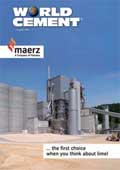Editorial comment
Prior to the recent crisis, the global cement industry went through an unprecedented period of prosperity. Supply-demand balance was very tight across most markets as they experienced above “long term trend” growth rates.
Register for free »
Get started now for absolutely FREE, no credit card required.
Prior to the recent crisis, the global cement industry went through an unprecedented period of prosperity. Supply-demand balance was very tight across most markets as they experienced above “long term trend” growth rates. The financial performance of the sector was stellar. The industry also saw significant levels of investment both in substantial capacity additions (incumbents and newcomers) and debt fuelled acquisitions. This crisis has illuminated the weaknesses of the sector. The capacity additions are expected to create supply-demand imbalances, the high level of indebtedness may lead to financial distress, which at best impedes growth, and the numerous new entrants increased the fragmentation of many regional and national markets. All this against the backdrop of dramatic demand reversals. It is no wonder the industry was driven into survival mode. Cement companies are currently thinking of only two things: cash preservation and cost cutting initiatives. Cash preservation is dictated by either their insecurity regarding the short to medium term macro development of their markets or the need to repair unhealthy balance sheets. Cutting down on CAPEX, postponing expansion plans and shunning potential acquisitions are the order of the day in the sector. In addition, there were promises of substantial disposals by many companies. Despite that, we have not yet seen any significant levels of M&A activity in the sector – nothing compared to the period between 2000 and 2007 in any event. Why is this?
Well, prospective buyers, if they decide to look at a potential deal, expect to acquire at excessively low prices in order to limit the impact of further macro deterioration. Sellers on the other hand are still thinking of pre-crisis historically elevated transaction multiples or are guided by asset valuations currently recorded in their books. As a result, the perspectives of buyers and sellers are out of synch. In addition, the latest spate of rights issues and debt refinancing indicates that the providers of funds (debt providers and shareholders) place significant value on cement assets. This may encourage potential sellers to hold on to their assets rather than give them away for a pittance (indeed, we have already seen such cases). Of course the role of the banks is pivotal in facilitating transactions. It is hoped and expected that now that many banks have availed themselves of large amounts of taxpayers’ money they will come back to the fray. How then can prospective buyers acquire assets that satisfy both the sellers’ expectations but more importantly address the uncertainty that surrounds acquisitions at the moment? Acquisitive cement companies face a simple but compelling conundrum. Do we go ahead with acquisitions now, risking further deterioration, or do we wait for a clearer picture and risk losing opportunities? Our dialogue with managers in acquisitive companies suggests that they are in search of tools to help make the picture clearer now. In answer to this, we propose the adoption of a pre-emptive short to medium term scenario planning process. This process armours the company with an understanding of the various realistic outcomes. In addition, it provides detailed and achievable action plans that the company can follow under the various scenarios. What are the aspects of a short to medium term scenario planning process? Of course, possible outcomes regarding the macroeconomic development of the relevant markets are the main consideration, but there are others. How will competitors behave under different scenarios? How will governments behave? How will legislation affect the cement industry? How will input costs develop? The usefulness of such planning is not only in identifying the most probable scenarios but also in identifying and dealing in advance with what might go wrong. In other words, what are the riskier aspects of each scenario and how they can be dealt with if they were to materialise. In our experience this process not only facilitates decision making but perhaps more importantly increases the confidence of the participating managers.
Short to medium term scenario planning can help acquisitive cement companies to grasp exciting opportunities with confidence. In doing so, these companies, will emerge through this crisis strong and successful.


